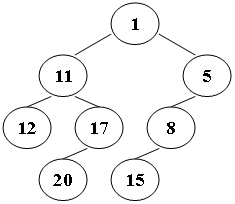PAT 1127 ZigZagging on a Tree
Suppose that all the keys in a binary tree are distinct positive integers. A unique binary tree can be determined by a given pair of postorder and inorder traversal sequences. And it is a simple standard routine to print the numbers in level-order. However, if you think the problem is too simple, then you are too naive. This time you are supposed to print the numbers in "zigzagging order" -- that is, starting from the root, print the numbers level-by-level, alternating between left to right and right to left. For example, for the following tree you must output: 1 11 5 8 17 12 20 15.

Input Specification:
Each input file contains one test case. For each case, the first line gives a positive integer N (≤30), the total number of nodes in the binary tree. The second line gives the inorder sequence and the third line gives the postorder sequence. All the numbers in a line are separated by a space.
Output Specification:
For each test case, print the zigzagging sequence of the tree in a line. All the numbers in a line must be separated by exactly one space, and there must be no extra space at the end of the line.
Sample Input:
8
12 11 20 17 1 15 8 5
12 20 17 11 15 8 5 1
Sample Output:
1 11 5 8 17 12 20 15
#include<iostream>//根据中,后序建树,再层级遍历
#include<vector>
#include<queue>
using namespace std;
int n;
vector<int> post(30, 0), in(30, 0);
struct node{
int val;
node* left=NULL;
node* right=NULL;
node(int v):val(v), left(NULL), right(NULL){
}
};
node* buildtree(node* root, int inl, int inr, int postl, int postr){
if(inl>inr) return NULL;
root=new node(post[postr]);
int i=inl;
while(i<=inr&&in[i]!=post[postr]) i++;
int cnt=i-inl;
root->left=buildtree(root->left, inl, i-1, postl, postl+cnt-1);
root->right=buildtree(root->right, i+1, inr, postl+cnt, postr-1);
return root;
}
int main(){
cin>>n;
for(int i=0; i<n; i++)
cin>>in[i];
for(int i=0; i<n; i++)
cin>>post[i];
node* root=NULL;
root=buildtree(root, 0, n-1, 0, n-1);
queue<node*> q;
int flag=0, k=0, level=0;
q.push(root);
cout<<root->val;
while(!q.empty()){
vector<node*> v;
while(!q.empty()){
node *t=q.front();
q.pop();
if(t->left) v.push_back(t->left);
if(t->right) v.push_back(t->right);
}
for(int i = 0; i < v.size(); i++)
q.push(v[i]);
if(level % 2 == 0)
for(int i = 0; i < v.size(); i++)
printf(" %d", v[i]->val);
else
for(int i = v.size() - 1; i >= 0; i--)
printf(" %d", v[i]->val);
level ++;
}
return 0;
}
PAT 1127 ZigZagging on a Tree的更多相关文章
- PAT 1127 ZigZagging on a Tree[难]
1127 ZigZagging on a Tree (30 分) Suppose that all the keys in a binary tree are distinct positive in ...
- PAT甲级1127. ZigZagging on a Tree
PAT甲级1127. ZigZagging on a Tree 题意: 假设二叉树中的所有键都是不同的正整数.一个唯一的二叉树可以通过给定的一对后序和顺序遍历序列来确定.这是一个简单的标准程序,可以按 ...
- PAT甲级 1127. ZigZagging on a Tree (30)
1127. ZigZagging on a Tree (30) 时间限制 400 ms 内存限制 65536 kB 代码长度限制 16000 B 判题程序 Standard 作者 CHEN, Yue ...
- pat 甲级 1127. ZigZagging on a Tree (30)
1127. ZigZagging on a Tree (30) 时间限制 400 ms 内存限制 65536 kB 代码长度限制 16000 B 判题程序 Standard 作者 CHEN, Yue ...
- 1127 ZigZagging on a Tree (30 分)
1127 ZigZagging on a Tree (30 分) Suppose that all the keys in a binary tree are distinct positive in ...
- PAT 甲级 1127 ZigZagging on a Tree
https://pintia.cn/problem-sets/994805342720868352/problems/994805349394006016 Suppose that all the k ...
- PAT Advanced 1127 ZigZagging on a Tree (30) [中序后序建树,层序遍历]
题目 Suppose that all the keys in a binary tree are distinct positive integers. A unique binary tree c ...
- PAT甲题题解-1127. ZigZagging on a Tree (30)-中序、后序建树
根据中序遍历和前序遍历确定一棵二叉树,然后按“层次遍历”序列输出.输出规则:除根节点外,接下来每层的节点输出顺序是:先从左到右,再从右到左,交替输出 #include <iostream> ...
- PAT A1127 ZigZagging on a Tree (30 分)——二叉树,建树,层序遍历
Suppose that all the keys in a binary tree are distinct positive integers. A unique binary tree can ...
随机推荐
- 清北考前刷题da7下午好
三向城 /* 原图一定是一棵完全二叉树. 根节点是x,左节点是x*2,右节点是x*2+1 转化为二进制往左右走就很明显了. */ #include<iostream> #include&l ...
- P2570 [ZJOI2010]贪吃的老鼠
传送门 →_→唯一一篇能看得懂的题解---->这里 很容易想到二分+网络流,然而并没有什么卵用--出题人的思路太神了-- 首先考虑如果一块奶酪在同一时间可以被多只老鼠吃的话,该如何建图.首先不难 ...
- laravel学习一
Laravel 是一款简洁,优雅的一款框架,可以说是入门TP后的第二款可以选择的框架. 目录部分: app -> 自己写的代码 http -> Controller -> 控制器 b ...
- 基于itchat实现微信群消息同步机器人
原始网址:http://www.jianshu.com/p/7aeadca0c9bd# 最近 全栈数据工程师养成攻略 的微信群已经将近500人,开了二群之后为了打通不同微信群之间的消息,花了点时间做了 ...
- Spring Cloud学习(一)
SpringCloud是什么? Spring Cloud是一个微服务框架,相比Dubbo等RPC框架, Spring Cloud提供的全套的分布式系统解决方案. Spring Cloud对微服务基础框 ...
- CF 334 div.2-D Moodular Arithmetic
思路: 易知k = 0的时候答案是pp-1,k = 1的时候答案是pp. 当k >= 2的时候,f(0) = 0,对于 1 <= n <= p - 1,如果f(n)确定,由题意可知f ...
- P2668 斗地主 dp+深搜版
题目描述 牛牛最近迷上了一种叫斗地主的扑克游戏.斗地主是一种使用黑桃.红心.梅花.方片的A到K加上大小王的共54张牌来进行的扑克牌游戏.在斗地主中,牌的大小关系根据牌的数码表示如下:3<4< ...
- iOS从手机相册选择一张照片并显示 Objective-C
要先给app设置访问相册的权限: 在项目的Info.plist文件里添加Privacy - Photo Library Usage Description权限 ViewController.h: #i ...
- DWARF调试格式的简介
DWARF调试格式的简介 Michael J. Eager, Eager Consulting Feb, 2007 翻译:吴晖 2012年2月 如果我们可以编写确保能正确工作且永远不需要调试的程序,这 ...
- std list/vector sort 自定义类的排序就是这么简单
所以,自己研究了一下,如下:三种方式都可以,如重写<,()和写比较函数compare_index.但是要注意对象和对象指针的排序区别. 1.容器中是对象时,用操作符<或者比较函数,比较函数 ...
